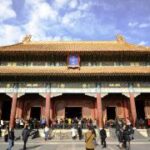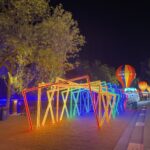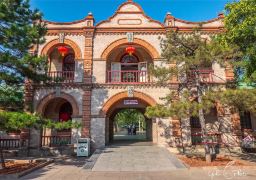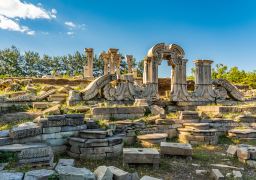The Wenhua Hall is a main hall located to the east of the three major halls of the Outer Court in the Forbidden City, facing the Wuying Hall to the west. It was built during the Yongle reign of the Ming Dynasty. Initially, it served as the place where the crown prince handled state affairs, with a green-tiled roof. Later, in the 15th year of the Jiajing era, it was transformed into an emperor’s private hall, with the roof changed to yellow tiles.
The imperial lecture ceremonies of the Ming and Qing dynasties were held in the Wenhua Hall during the spring and autumn equinoxes each year. During these ceremonies, the emperor would write imperial essays to express his insights from studying the ‘Four Books and Five Classics’, while civil officials would kneel before him, listening to the emperor’s discourse and sometimes engaging in debates when called upon by the emperor. Behind the Wenhua Hall is the Wenyuan Pavilion, which houses a collection of literary classics, serving as the emperor’s library. After the lecture ceremonies, as a special reward for the civil officials who participated in the ceremony, the emperor would lead them from Wenhua Hall to Wenyuan Pavilion to view the valuable books in the pavilion. The grading of the imperial examination papers also took place in Wenhua Hall, and important civil officials from the cabinet would be honored with the title of Wenhua Hall University Scholar. Nowadays, Wenhua Hall has been transformed into the Porcelain Pavilion, where experts from the Palace Museum have selected over 400 pieces of fine ceramics from the Ming and Qing royal collections of 350,000 pieces, arranged and displayed in chronological order for visitors to appreciate and study. The exhibition hall is divided into several areas: Dawn of Civilization, Traces of Porcelain, Unique Celadon, Southern Celadon and Northern White, Succession of Famous Kilns, Foundation of the Porcelain Capital, Prosperity, Fresh and Elegant, Pinnacle, Revival, and Going Global. There are three exhibition halls, with Hall 1 featuring exhibits mainly from late Neolithic pottery to Qing Dynasty Guangcai porcelain, including representative pieces such as the Tang Dynasty Celadon Octagonal Vase, Ming Jiajing Five-Color Fish and Aquatic Plants Pattern Jar, Jingdezhen Kiln Blue and White Seawater White Dragon Pattern Octagonal Plum Vase, and Tang Sancai. Halls 2 and 3 feature Ming and Qing court porcelain, with representative pieces such as the Yongzheng Pink Enamel Peach Pattern Celestial Sphere Vase and Qianlong Enamel Lotus Pattern Double-Connected Bottle.Opening hours and specific business status are subject to the day’s opening conditions.









